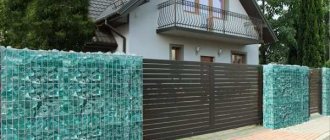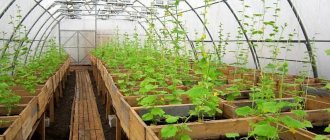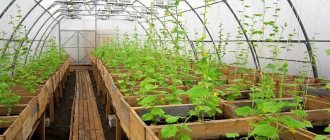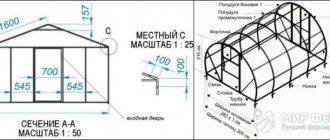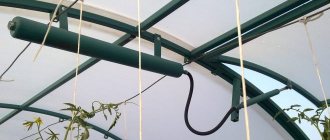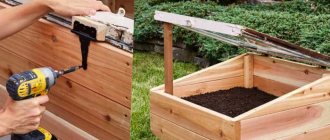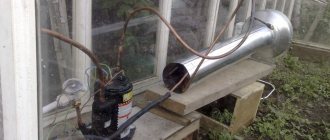Having planted seedlings in greenhouses, the vegetable grower is in constant excitement: during the day, the young leaves will be warmed by the spring sun, and night frosts can destroy them. If the costs of building a stove are not planned, you can act more rationally. The simplest heat accumulator with the funny name “Lezheboka” will itself lie quietly between the beds, and will allow the owner to sleep peacefully. From the article, the reader will learn why such a device receives positive reviews and how to make it from scrap materials with your own hands.
Heat accumulators for greenhouses
Despite the fact that greenhouses are created in order to grow crops throughout the year, their efficiency often drops quite significantly in winter. This is due, first of all, to the insufficient coefficient of heat accumulation during cold periods due to a decrease in the average daily air temperature and a decrease in daylight hours. You can solve this problem by equipping your greenhouse with a heat accumulator, some varieties of which will be discussed in this article.
How it works
The basic principles of operation of any greenhouse are based on the fact that solar energy entering the greenhouse premises is accumulated there, and due to the heat-reflecting properties of the covering materials that make up the walls and roof of the greenhouse, it goes outside in much smaller quantities than initially received. However, excess energy that is not used directly by the plants themselves is simply dissipated in space and does not bring any benefit. Did you know? The first working prototype of a modern battery was proposed in 1802 by the Italian Alessandro Volta. It consisted of copper and zinc sheets, which were joined together by soldering and placed in a wooden box filled with acid.
If you organize the collection of excess solar energy in a greenhouse and ensure its further adequate storage and use, this will entail an increase in the productivity of its work. The accumulated heat can be used to maintain a constant comfortable indoor temperature level at any time of the day, which will improve the germination and yield of your crops. Find out how to properly treat a polycarbonate greenhouse in the spring. An important positive factor in the construction of batteries of this type is also the fact that you do not have to spend money on various expensive energy resources, many electronic components and other components required for the construction of traditional heating systems.
What else is suitable for accumulating heat for seedlings?
Water is the best heat storage device, but not the only one. There are other materials that can be used to protect seedlings from frost:
- bricks;
- flat stones;
- concrete paths
- plastic bottles.
Bottles as a heat accumulator
Clay and stone heat up well and release energy for a long time. This property is inherent in the design of Russian and other folk stoves. For guaranteed results, you can combine water and stone batteries.
“Lezheboka” is not omnipotent, but it is capable of raising the night temperature in the greenhouse at soil level by 8 degrees. In other words, during frosts of minus 5 degrees, the air around the seedlings will maintain a positive temperature. Place a couple of plump couch potatoes in your greenhouse, and you won’t have to flinch when you look at the thermometer in the evening twilight.
DIY water heat accumulators
The most popular and easiest to construct heat accumulator for a greenhouse is a water accumulator. Next, we will look at some of the simplest ways to construct such closed-type batteries. If you have just decided to acquire a polycarbonate greenhouse, it will be useful for you to study all the design features of these greenhouses; find out which foundation is suitable for this greenhouse, how to choose polycarbonate for your greenhouse, and also how to make a polycarbonate greenhouse with your own hands.
Sleeve type
This unit is good because of the simplicity of its construction, because all you need for it is an elastic sealed sleeve and water. An approximate algorithm for the production of this battery:
- A purchased sealed sleeve (preferably black) of the required length and width, which can vary depending on the length of the beds and the type of plants grown, is placed on the bed in such a way that when filled it does not injure the plants.
- Next, one of the edges of the sleeve is cut and water is poured into it so that it fills it as tightly as possible.
- Next, the sleeve is resealed by twisting its edge with twine, wire, electrical tape or a clamp.
Review and production of heat accumulators for a greenhouse with your own hands
By creating an effective heating system, a greenhouse structure can function even in severe frosts. However, for most gardeners, operating a greenhouse in winter is quite expensive due to high energy costs. However, there are ways to use absolutely free solar energy.
In the video, the heat accumulator:
What does heat storage provide?
The solar energy entering the greenhouse is accumulated inside due to the characteristics of the covering material. But even in winter, the volume of this energy is significantly higher than the needs of plants. Excess heat is simply reflected into space without any benefit.
The use of solar energy accumulation in a greenhouse will allow the heat reserves to be successfully used for heating.
As a result, the temperature in the shelter is kept at the required levels and there are no electricity costs to heat the greenhouse structure.
Possible options for thermal accumulators
Thermal accumulators for greenhouses are devices for storing solar energy. They differ in the materials from which their main component, the heat accumulator, is made.
Do you do canning?
Heating in a greenhouse - review:
Water heat accumulators
In them, heat accumulates in water tanks located in the shelter. There are two types of reservoirs:
- Outdoor (swimming pools). The open type has a distinctive feature: their effectiveness is determined by the amount of air above the pool. When the sun heats up, it causes water to evaporate and takes away the necessary heat. The duration of evaporation depends on the amount of dry air. It is recommended to cover the pool with film to prevent heat loss due to water evaporation;
- Closed (barrels). The presence of several compact water tanks will provide significantly higher efficiency compared to one large container. This process is the result of the inability of solar energy to penetrate a large thickness of water. Therefore, the battery heats up only at the top and near the walls. The rest of the liquid is still cold for a long time. To improve heating efficiency, more small closed heat accumulators are being installed. They will quickly warm up and subsequently provide uniform heat transfer.
Heat accumulation in the soil
The soil in each greenhouse has the ability to accumulate heat in order to be used for heating at night. During the day, the soil is simply warmed by the sun and it absorbs its heat. At night the following process occurs:
- In vertical pipes located in warm soil, the air is heated;
- Warm air begins to move to a higher vertical pipe, which has greater draft;
- Cooled air passes through a low vertical pipe under the ground and the process resumes.
Stone heat accumulators
Due to the fact that natural stone has a significant heat capacity, it is used in shelters as a heat accumulator. Often the back wall of the structure, which is well illuminated by the sun's rays, is lined with stone. A simple type of stone heat accumulator is a greenhouse wall lined with stone. More complex options include laying or pouring stone in several layers.
Solar air collector for heating greenhouses
Another device that fully uses solar energy for heating is a solar collector. Its main component is a heat exchanger; air from the greenhouse circulates inside it. How does a solar collector work:
- Installation of solar panels outside is carried out perpendicular to the sun's rays. The rays will not be reflected and the energy will turn into heat;
- From the heat exchanger, air will flow into the heated structure;
- After the heat is transferred to the soil and crops, after cooling, the air enters the heat exchanger and the greenhouse shelter is reheated using solar panels.
The process of heating a greenhouse with a solar collector has many differences from the use of heat accumulators:
- The collector operates only during the day;
- It is impossible to heat the greenhouse at night if there is no additional heating system;
- The collector does not have the ability to accumulate thermal energy. He only carries out its effective distribution.
Heat accumulator for a greenhouse: how to make it yourself?
Placing such a heating device in an already built greenhouse is almost impossible. It is necessary to create a heat accumulator before constructing the frame. Step-by-step instruction:
- A pit is dug along the entire perimeter of the structure, the depth of which should be about 30 cm. It is worth preserving the top layer with humus, since fertile soil will still be needed for the greenhouse;
- The bottom of the pit must be filled with coarse sand or small crushed stone. Thoroughly compact each 10 cm layer;
- Create a system of horizontal air ducts, placing them along the length of the beds. For horizontal air ducts, preference is given to plastic sewer pipes (optimal diameter 110 mm). To combine them into the required structure, tees and crosses are used;
- Fans are installed in the inlet and outlet pipes, taking into account the direction of the air flow.
When using heat accumulators for heating greenhouses, the costs of maintaining them are significantly reduced. At the same time, the costs of purchasing materials are fully reimbursed by obtaining an additional harvest. In addition, there is no need to involve specialists, since heat accumulators can be made by hand.
source: web-selo.ru
An excellent tool for craftsmen and handicrafts, and everything for the garden, home and cottage is literally free - see for yourself. there are reviews
Greenhouses and greenhouses do not always save you from spring and autumn frosts, and the installation of heating systems requires significant financial investments. I did without this by increasing the heat capacity of the polycarbonate greenhouse using available materials.
What best retains the heat accumulated during the day? Water. However, installing barrels will reduce the usable area of the greenhouse. So I decided to use ordinary plastic bottles, of which there are countless numbers found in our vast expanses.
During the spring-summer season, about 500 eggplants with a capacity of 0.5 liters to 5 liters were removed from the territory of the park and the banks of the Volga. Their total volume was approximately 700 liters.
I placed the bottles on high beds (here they warm up better in the spring) between the plants. This immediately reduced overheating of the soil: while the seedlings are still low, the open soil becomes very hot under the sun's rays.
Tools for home and garden, handicrafts, etc. prices are very low
The daily temperature changes immediately became noticeably smaller: the water, which had warmed up during the day, gradually gave off heat at night to the ground and air of the greenhouse.
If possible, you need to fill the entire free area with such bottles, or even better, when designing the greenhouse, provide a place in advance (say, on the north side) to place these bottles vertically along the entire wall in several tiers.
In the fall, when night temperatures reached sub-zero levels, my budget heat accumulator coped with its task adequately.
At minus 3° in the morning it was 10° in the greenhouse. Tomatoes, peppers, eggplants and cucumbers planted under experimental conditions bore fruit until the end of October.
In a simple greenhouse (without a heat accumulator), and especially in open ground, vegetables have long since withered and died.
source: kak-svoimi-rukami.com
Good afternoon Please help me with advice. I want to make a greenhouse at the dacha for growing seedlings and early vegetables, but heating it is quite a troublesome task and an expensive pleasure.
Recently I heard that there is a special device - a heat accumulator for a greenhouse that can help solve this problem.
Tell us more about these batteries: what are they and how to use them?
Modern industry produces heat accumulators for greenhouses, the essence of which is that they are heated by the sun's rays during the day, and then gradually release this heat at night. Thanks to this, it is easy to maintain a comfortable microclimate in a confined space and protect plants from hypothermia.
Typically, thick black polyethylene film is used to make such drives. This choice is not accidental, because black is the color that accumulates heat best.
Film containers are filled with ordinary water, it heats up during daylight hours, and at night the heat is radiated into the environment. Thanks to these simple laws of physics, containers can warm up under the influence of sunlight to 20-25°C even in fairly cool but sunny weather.
If the temperature outside the greenhouse drops below zero, batteries will make it possible to maintain a microclimate that is comfortable for plants.
It is quite possible to make a heat accumulator for a greenhouse yourself. For this purpose, you can use dark-colored stones, brick or crushed stone coated with black paint. One material that is definitely not suitable is metal: it releases the accumulated thermal energy too quickly.
The most budget-friendly way is to lay metal-plastic pipes filled with water and painted black in the greenhouse. You can also use eggplants filled with water.
Heat accumulators are indispensable if you do not have the opportunity to visit your summer cottage every day. In addition, they provide an opportunity to save a lot of money. Therefore, feel free to start arranging the greenhouse, and the result will not be long in coming.
source: teplichniku.ru
(23 4,11 of 5) Loading...
Source: https://stroimds.ru/stati/obzor-i-izgotovlenie-akkumulyatorov-tepla-dlya-teplitsy-svoimi-rukami.html
Heat accumulators for greenhouses made of polycarbonate
In early spring, seedlings planted in a greenhouse or greenhouse often suffer from return frosts. Not all gardeners have the opportunity to heat greenhouse structures using stoves, electricity or gas. This is expensive and requires constant monitoring, which summer residents cannot organize when they visit their plots intermittently. And here simple and inexpensive heat accumulators for greenhouses and greenhouses can come to the rescue.
What is a simple heat accumulator?
These devices are designed to accumulate heat during periods of active sun and then release it during the cold season. From traditional batteries, which are used in various heating devices or cars, devices for heating greenhouses and hotbeds differ radically in the material of manufacture, which is used as:
- Plastic pipes.
- Natural or artificial stone.
- Sleeves made of black polyethylene film.
- Plastic containers and other items that can hold water.
The principle of solar heating of a greenhouse with water
The operation of such a device is based on the use of ordinary water, which is poured inside a sleeve or container. During the daytime, when the sun shines brightly, in a greenhouse, even in early spring, a high temperature is created, sometimes reaching +25-30 degrees. Naturally, the water also heats up to a high temperature during the day and gives off its heat at night, warming the air and soil in the greenhouse. Thus, if it is -3 degrees outside at night, then in a greenhouse with a heat accumulator the temperature will remain at +3-4 degrees, as a result of which the seedlings will not die and the gardener’s work will not go to waste. A greater effect when heating a greenhouse with solar energy can be achieved if you use containers of a dark color, preferably black.
An example would be an outdoor shower, above which black or dark-colored barrels are installed.
Possible options for thermal accumulators
Thermal accumulators for greenhouses are devices for storing solar energy. They differ in the materials from which their main component, the heat accumulator, is made.
Heating in a greenhouse - review:
Water heat accumulators
In them, heat accumulates in water tanks located in the shelter. There are two types of reservoirs:
- Outdoor (swimming pools). The open type has a distinctive feature: their effectiveness is determined by the amount of air above the pool. When the sun heats up, it causes water to evaporate and takes away the necessary heat. The duration of evaporation depends on the amount of dry air. It is recommended to cover the pool with film to prevent heat loss due to water evaporation;
- Closed (barrels). The presence of several compact water tanks will provide significantly higher efficiency compared to one large container. This process is the result of the inability of solar energy to penetrate a large thickness of water. Therefore, the battery heats up only at the top and near the walls. The rest of the liquid is still cold for a long time. To improve heating efficiency, more small closed heat accumulators are being installed. They will quickly warm up and subsequently provide uniform heat transfer.
Heat accumulation in the soil
The soil in each greenhouse has the ability to accumulate heat in order to be used for heating at night. During the day, the soil is simply warmed by the sun and it absorbs its heat. At night the following process occurs:
- In vertical pipes located in warm soil, the air is heated;
- Warm air begins to move to a higher vertical pipe, which has greater draft;
- Cooled air passes through a low vertical pipe under the ground and the process resumes.
Stone heat accumulators
Due to the fact that natural stone has a significant heat capacity, it is used in shelters as a heat accumulator. Often the back wall of the structure, which is well illuminated by the sun's rays, is lined with stone. A simple type of stone heat accumulator is a greenhouse wall lined with stone. More complex options include laying or pouring stone in several layers.
Do-it-yourself heat accumulator for a greenhouse or greenhouse
Heat conservation in a greenhouse can be organized by using a sleeve made of plastic film for a heat accumulator in a greenhouse or greenhouse, plastic bottles, or buying a couch potato heat accumulator.
When using a sleeve, you will have to independently make a sealed plug at the ends of the sleeve, which is not always possible, given the thickness of the film, which reaches 200 - 250 microns. Water may slowly seep in and then you will have to constantly add it. This can be called a minus, but the plus is that the sleeve can be cut to any length, while the finished product “Lezheboka” is produced in a certain length, which may not be enough if the size of the greenhouse is significant. And the cost of the sleeve is tens of times less than the finished product.
However, the ready-made device has a significant advantage:
- Hermetically sealed sleeve ends.
- There is a hole with a plug where you can easily add water.
Both the sleeves and the couch potato are placed on the beds of the greenhouse in the right direction so as not to damage the seedlings.
How to accumulate energy for a GREENHOUSE!
Reviews:
Mikolo Isidorovich Palyga
writes: SUPER OVEN Mikolo Palygi for heating the GREENHOUSE.
Ruslan Bulatov
writes: What is the total volume of the greenhouse and what is the total volume of the heat accumulator?
Mikolo Isidorovich Palyga
writes: SUPER OVEN Mikolo Palygi for heating the GREENHOUSE.
Ruslan Bulatov
writes: What is the total volume of the greenhouse and what is the total volume of the heat accumulator?
You can improve heating efficiency by installing a huge number of small closed aqua heat accumulators. They should be placed sparingly over the entire area of the greenhouse. This will allow them to warm up faster and, in the future, give off heat more moderately.
Alternative ways to preserve heat in a greenhouse
Considering that the operation of a heat accumulator is based on the ability to accumulate solar heat and release it gradually, stones, pebbles, sand or bricks are quite suitable for making such devices with your own hands. Surely many have noticed that late in the evening after a hot day, the walls of a brick house, sand on the beach or water in a river or lake retain daytime heat for a long time. All of the above materials can show exactly the same effect in a greenhouse or greenhouse, protecting tender seedlings from the cold.
Large stones can be laid out on the beds around the perimeter, sand can be scattered over the entire area after planting the seedlings. In the further operation of the greenhouse in the summer, sand will still play the role of a loosening agent if the soil is heavy.
Hollow plastic pipes are dug vertically into the soil of beds or paths. During the day, the air in the pipes will be well warmed up by the heat of the sun, and at night, when the temperature drops, it will rush upward, observing the law of physics and heating the interior of the greenhouse.
But, according to many gardeners, the best heat accumulator for greenhouses is a black polyethylene sleeve, which is inexpensive and can be used in greenhouses of any size. In conclusion, I suggest watching a video about organizing heating of greenhouses with your own hands.
What does "Lezheboka" look like?
“Lezheboka” is a long, dense black polyethylene sleeve, on one side of which there is a hole with a screw thread, equipped with a screw cap. The length of the sleeve is 4 m, width – 21 cm. After filling with water, the width of the product will decrease to approximately 15 cm.
Operating principle of the “Lezheboka” battery
Water is poured inside through the hole, leaving a third of the sleeve empty. If possible, deflate the air, screw on the cap and place the sleeve in the aisle. It works independently: during the day, the black film absorbs heat and releases it to water; at night, the heat slowly returns to the atmosphere.
Attention! For the winter, “Lezhebok” should be emptied of water and stored.
Battery "Lezhebok" in the greenhouse
The polyethylene used for “Lezheboki” is quite thick - 250 microns - but it can also tear. In this case, the water is drained from the sleeve, a patch made of a similar film is placed over the rupture using a special glue (BF, trichlorethylene), after a few hours it is filled again and continues to be used.
Heat accumulators for greenhouses
Despite the fact that greenhouses are created in order to grow crops throughout the year, their efficiency often drops quite significantly in winter. This is due, first of all, to the insufficient coefficient of heat accumulation during cold periods due to a decrease in the average daily air temperature and a decrease in daylight hours. You can solve this problem by equipping your greenhouse with a heat accumulator, some varieties of which will be discussed in this article.
How it works
The basic principles of operation of any greenhouse are based on the fact that solar energy entering the greenhouse premises is accumulated there, and due to the heat-reflecting properties of the covering materials that make up the walls and roof of the greenhouse, it goes outside in much smaller quantities than initially received. However, excess energy that is not used directly by the plants themselves is simply dissipated in space and does not bring any benefit. Did you know? The first working prototype of a modern battery was proposed in 1802 by the Italian Alessandro Volta. It consisted of copper and zinc sheets, which were joined together by soldering and placed in a wooden box filled with acid.
If you organize the collection of excess solar energy in a greenhouse and ensure its further adequate storage and use, this will entail an increase in the productivity of its work. The accumulated heat can be used to maintain a constant comfortable indoor temperature level at any time of the day, which will improve the germination and yield of your crops. Find out how to properly treat a polycarbonate greenhouse in the spring. An important positive factor in the construction of batteries of this type is also the fact that you do not have to spend money on various expensive energy resources, many electronic components and other components required for the construction of traditional heating systems.
DIY water heat accumulators
The most popular and easiest to construct heat accumulator for a greenhouse is a water accumulator. Next, we will look at some of the simplest ways to construct such closed-type batteries. If you have just decided to acquire a polycarbonate greenhouse, it will be useful for you to study all the design features of these greenhouses; find out which foundation is suitable for this greenhouse, how to choose polycarbonate for your greenhouse, and also how to make a polycarbonate greenhouse with your own hands.
Sleeve type
This unit is good because of the simplicity of its construction, because all you need for it is an elastic sealed sleeve and water. An approximate algorithm for the production of this battery:
- A purchased sealed sleeve (preferably black) of the required length and width, which can vary depending on the length of the beds and the type of plants grown, is placed on the bed in such a way that when filled it does not injure the plants.
- Next, one of the edges of the sleeve is cut and water is poured into it so that it fills it as tightly as possible.
- Next, the sleeve is resealed by twisting its edge with twine, wire, electrical tape or a clamp.
Heat accumulators for greenhouses made of polycarbonate
In early spring, seedlings planted in a greenhouse or greenhouse often suffer from return frosts. Not all gardeners have the opportunity to heat greenhouse structures using stoves, electricity or gas. This is expensive and requires constant monitoring, which summer residents cannot organize when they visit their plots intermittently. And here simple and inexpensive heat accumulators for greenhouses and greenhouses can come to the rescue.
What is a simple heat accumulator?
These devices are designed to accumulate heat during periods of active sun and then release it during the cold season. From traditional batteries, which are used in various heating devices or cars, devices for heating greenhouses and hotbeds differ radically in the material of manufacture, which is used as:
- Plastic pipes.
- Natural or artificial stone.
- Sleeves made of black polyethylene film.
- Plastic containers and other items that can hold water.
Greenhouse heat accumulator - how it works
The heat accumulator is used in greenhouses and greenhouses to equalize day and night temperatures. It works in full accordance with the laws of physics. Many substances are capable of absorbing and storing heat arriving at their surface. As soon as the energy source ceases to operate, the accumulated heat gradually moves from the heated body to the atmosphere.
Lounger heat accumulator
In the case of a greenhouse, the energy source is the sun, the atmosphere should be understood as the air inside the room, and the heat storage is water.
Why water? This substance, not coincidentally called the cradle of life, is notable for three important qualities:
- An impressive heat capacity, ten times greater than that of iron.
- Slow heat transfer. This property of water allows the oceans to smooth out the temperatures of different seasons of the year on a planetary scale.
- Availability. For a heat accumulator, water from a water supply system, a well, or an open reservoir is suitable.
The heat accumulator is placed on the beds
Advice. The water container should be black, since black does not reflect light rays, completely absorbing all the heat provided to it.
If the size of the greenhouse allows, water can be poured into a barrel to collect heat. In small greenhouses and greenhouses, sealed plastic containers are used.
The principle of solar heating of a greenhouse with water
The operation of such a device is based on the use of ordinary water, which is poured inside a sleeve or container. During the daytime, when the sun shines brightly, in a greenhouse, even in early spring, a high temperature is created, sometimes reaching +25-30 degrees. Naturally, the water also heats up to a high temperature during the day and gives off its heat at night, warming the air and soil in the greenhouse. Thus, if it is -3 degrees outside at night, then in a greenhouse with a heat accumulator the temperature will remain at +3-4 degrees, as a result of which the seedlings will not die and the gardener’s work will not go to waste. A greater effect when heating a greenhouse with solar energy can be achieved if you use containers of a dark color, preferably black.
An example would be an outdoor shower, above which black or dark-colored barrels are installed.
Solar air collector for heating greenhouses
Another device that fully uses solar energy for heating is a solar collector. Its main component is a heat exchanger; air from the greenhouse circulates inside it. How does a solar collector work:
- Installation of solar panels outside is carried out perpendicular to the sun's rays. The rays will not be reflected and the energy will turn into heat;
- From the heat exchanger, air will flow into the heated structure;
- After the heat is transferred to the soil and crops, after cooling, the air enters the heat exchanger and the greenhouse shelter is reheated using solar panels.
The process of heating a greenhouse with a solar collector has many differences from the use of heat accumulators:
- The collector operates only during the day;
- It is impossible to heat the greenhouse at night if there is no additional heating system;
- The collector does not have the ability to accumulate thermal energy. He only carries out its effective distribution.
Do-it-yourself heat accumulator for a greenhouse or greenhouse
Heat conservation in a greenhouse can be organized by using a sleeve made of plastic film for a heat accumulator in a greenhouse or greenhouse, plastic bottles, or buying a couch potato heat accumulator.
When using a sleeve, you will have to independently make a sealed plug at the ends of the sleeve, which is not always possible, given the thickness of the film, which reaches 200 - 250 microns. Water may slowly seep in and then you will have to constantly add it. This can be called a minus, but the plus is that the sleeve can be cut to any length, while the finished product “Lezheboka” is produced in a certain length, which may not be enough if the size of the greenhouse is significant. And the cost of the sleeve is tens of times less than the finished product.
However, the ready-made device has a significant advantage:
- Hermetically sealed sleeve ends.
- There is a hole with a plug where you can easily add water.
Both the sleeves and the couch potato are placed on the beds of the greenhouse in the right direction so as not to damage the seedlings.
Do-it-yourself "sloth"
The models of heat accumulators offered by the industry do not contain complex components, which allows you to manufacture them yourself if desired.
The quickest and easiest way to create a heat collection container is to use a large black trash bag. The bottom of such a bag is already hermetically sealed. The bag is placed on the ground, water is poured halfway into it, the edges are twisted and tied, and then placed in the aisle.
The disadvantage of this design is its fragility. It is much safer to use plastic pipes used for sewer installation.
A heat accumulator can be made from a black garbage bag
To do this, select a pipe of maximum diameter: the more liquid that fits into it, the more efficiently the product will work. When choosing the length of the pipe, you should proceed from the dimensions of the greenhouse and ease of use. The outside of the pipe should be coated with black paint.
The ends of the pipe are tightly welded or sealed with plugs of the appropriate diameter. A hole is cut in the center of the pipe to fill with water and a plug is selected for it. A container filled with liquid with a stopper installed in the hole is ready for use.
Advice. To avoid carrying heavy containers around the garden, fill the battery with water in the place where it is intended to lie. To make the process easier, use a funnel.

